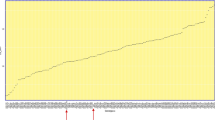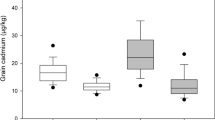Abstract
The heavy metal cadmium (Cd) is highly toxic to humans and can enter food chains from contaminated crop fields. Understanding the molecular mechanisms of Cd accumulation in crop species will aid production of safe Cd-free food. Here, we identified a single recessive gene that allowed higher Cd translocation in rice, and also determined the chromosomal location of the gene. The Cd hyperaccumulator rice variety Cho-Ko-Koku showed 3.5-fold greater Cd translocation than the no-accumulating variety Akita 63 under hydroponics. Analysis of an F2 population derived from these cultivars gave a 1:3 segregation ratio for high:low Cd translocation. This indicates that a single recessive gene controls the high Cd translocation phenotype. A QTL analysis identified a single QTL, qCdT7, located on chromosome 7. On a Cd-contaminated field, Cd accumulation in the F2 population showed continuous variation with considerable transgression. Three QTLs for Cd accumulation were identified and the peak of the most effective QTL mapped to the same region as qCdT7. Our data indicate that Cd translocation mediated by the gene on qCdT7 plays an important role in Cd accumulation on contaminated soil.







Similar content being viewed by others
References
Akagi H, Yokozeki Y, Inagaki A, Fujimura T (1996) Microsatellite DNA markers for rice chromosomes. Theor Appl Genet 93:1071–1077
Arao T, Ae N (2003) Genotypic variations in cadmium levels of rice grain. Soil Sci Plant Nutr 49:473–479
Baker AJM, McGrath SP, Reeves RD, Smith JAC (2000) Metal hyperaccumulator plants: a review of the ecology and physiology of a biochemical resource for phytoremediation of metal-polluted soils. In: Terry N, Banuelos G (eds) Phytoremediation of contaminated soil and water. Lewis Publishers, Boca Raton, Florida, pp 85–107
Bert V, Bonnin I, Saumitou-Laprade P, de Laguérie P, Petit D (2002) Do Arabidopsis halleri from nonmetallicolous populations accumulate zinc and cadmium more effectively than those from metallicolous populations? New Phytol 155:47–57
Clemens S (2006) Toxic metal accumulation, responses to exposure and mechanisms of tolerance in plants. Biochimie 88:1707–1719
Clemens S, Palmgren MG, Kramer U (2002) A long way ahead: understanding and engineering plant metal accumulation. Trends Plant Sci 7:309–315
Courbot M, Willems G, Motte P, Arvidsson S, Roosens N, Saumitou-Laprade P, Verbruggen N (2007) A major quantitative trait locus for cadmium tolerance in Arabidopsis halleri colocalizes with HMA4, a gene encoding a heavy metal ATPase. Plant Physiol 144:1052–1065
Edwards K, Johnstone C, Thompson C (1991) A simple and rapid method for the preparation of plant genomic DNA for PCR analysis. Nucleic Acids Res 19:1349
Hanikenne M, Talke IN, Haydon MJ, Lanz C, Nolte A, Motte P, Kroymann J, Weigel D, Krämer U (2008) Evolution of metal hyperaccumulation required cis-regulatory changes and triplication of HMA4. Nature 453:391–395
Ibaraki T, Kuroyanagi N, Murakami M (2009) Practical phytoextraction in cadmium-polluted paddy fields using a high cadmium accumulating rice plant cultured by early drainage of irrigation water. Soil Sci Plant Nutr 55:421–427
International Rice Genome Sequencing Project (2005) The map-based sequence of the rice genome. Nature 436:793–800
Ishikawa S, Ae N, Sugiyama M, Murakami M, Arao T (2005a) Genotypic variation in shoot cadmium concentration in rice and soybean in soils with different levels of cadmium contamination. Soil Sci Plant Nutr 51:101–108
Ishikawa S, Ae N, Yano M (2005b) Chromosomal regions with quantitative trait loci controlling cadmium concentration in brown rice (Oryza sativa). New Phytol 168:345–350
Kato H, Tezuka K, Feng YY, Kawamoto T, Takahashi H, Mori K, Akagi H (2007) Structural diversity and evolution of the Rf-1 locus in the genus Oryza. Heredity 99:516–524
Lander ES, Green P, Abrahamson J, Barlow A, Daly MJ, Lincoln SE, Newberg LA (1987) MAPMAKER: an interactive computer package for constructing primary genetic linkage maps of experimental and natural populations. Genomics 1:174–181
Liu JG, Li KQ, Xu JK, Liang JS, Lu XL, Yang JC, Xhu QS (2003) Interaction of Cd and five mineral nutrients for uptake and accumulation in different rice cultivars and genotypes. Field Crops Res 83:271–281
Matsumoto S, Ito M, Masaki S, Kodama I, Kawamoto T, Nakagawa S, Itani T (2005) Selection of rice varieties with high cadmium contents (in Japanese). Jpn J Crop Sci 74(2):150
McCouch SR, Teytelman L, Xu Y, Lobos KB, Clare K, Walton M, Fu B, Maghirang R, Li Z, Xing Y, Zhang Q, Kono I, Yano M, Fjellstrom R, DeClerck G, Schneider D, Cartinhour S, Ware D, Stein L (2002) Development and mapping of 2240 new SSR markers for rice (Oryza sativa L.). DNA Res 9:199–207
Morel M, Crouzet J, Gravot A, Auroy P, Leonhardt N, Vavasseur A, Richaud P (2009) AtHMA3, a P1B-ATPase allowing Cd/Zn/Co/Pb vacuolar storage in Arabidopsis. Plant Physiol 149:894–904
Morishita T, Fumoto N, Yoshizawa T, Kagawa K (1987) Varietal differences in cadmium levels of rice grains of Japonica, Indica, Javanica and hybrid varieties produced in the same plot of a field. Soil Sci Plant Nutr 33:629–637
Murakami M, Nakagawa F, Ae N, Ito M, Arao T (2009) Phytoextraction by rice capable of accumulating Cd at high levels: reduction of Cd content of rice grain. Environ Sci Technol 43:5878–5883
Temnykh S, Park WD, Ayres N, Cartinhour S, Hauck N, Lipovich L, Cho YG, Ishii T, McCouch SR (2001) Mapping and genome organization of microsatellite sequences in rice (Oryza sativa L.). Theor Appl Genet 100:697–712
Ueno D, Kono I, Yokosho K, Ando T, Yano M, Ma JF (2009) A major quantitative trait locus controlling cadmium translocation in rice (Oryza sativa). New Phytol 182:644–653
Uraguchi S, Mori S, Kuramata M, Kawasaki A, Arao T, Ishikawa S (2009) Root-to-shoot Cd translocation via the xylem is the major process determining shoot and grain cadmium accumulation in rice. J Exp Bot. doi:10.1093/jxb/erp119
Wang S, Basten CJ, Zeng ZB (2007) Windows QTL cartographer 2.5. North Carolina State University, Raleigh
Acknowledgments
The authors thank Dr Hiroyuki Hattori, Dr Shinichi Nakamura, Dr Yoshihiro Kaneta (Akita Prefectural University) and Mr Masashi Ito (Akita Agricultural Experimental Station) for analysis of metals. This research was supported by a grant from the Ministry of Agriculture and Forestry of Japan (Genomics for Agricultural Innovation, RGB-2404).
Author information
Authors and Affiliations
Corresponding author
Additional information
Communicated by M. Xu.
Electronic supplementary material
Below is the link to the electronic supplementary material.
122_2009_1244_MOESM1_ESM.tif
Fig. S1. Frequency distribution of Cd accumulation in shoots and roots of F2 seedlings grown under hydroponic culture conditions. The 144 F2 seedlings were grown in a nutrient solution with 5 μg L−1 of CdCl2 for 20 days. Means and standard deviations of the parental translocation rates are also included. CKK and A63 represent Cho-Ko-Koku and Akita 63, respectively (TIFF 333 kb)
122_2009_1244_MOESM2_ESM.tif
Fig. S2. Frequency distributions of Cd concentrations in shoots and roots of F2 seedlings grown under hydroponic culture conditions. The 144 F2 seedlings were grown in a nutrient solution with 5 μg L−1 of CdCl2 for 20 days. Means and standard deviations of the parental translocation rates are also included. CKK and A63 represent Cho-Ko-Koku and Akita 63, respectively (TIFF 324 kb)
122_2009_1244_MOESM3_ESM.tif
Fig. S3. Frequency distribution of the Cd concentration in shoots of the F2 population grown on the Cd-polluted paddy field. The cadmium concentration and dry weight in the shoots of 142 F2 plants were analyzed. CKK and A63 represent means and standard deviations of Cd accumulation in Cho-Ko-Koku and Akita 63, respectively (TIFF 148 kb)
122_2009_1244_MOESM4_ESM.tif
Fig. S4. Frequency distribution of the shoots dry weights of the F2 population grown on the Cd-polluted paddy field. The cadmium concentrations and dry weights in the shoots of 142 F2 plants were analyzed. CKK and A63 represent means and standard deviations of Cd accumulation in Cho-Ko-Koku and Akita 63, respectively (TIFF 138 kb)
Rights and permissions
About this article
Cite this article
Tezuka, K., Miyadate, H., Katou, K. et al. A single recessive gene controls cadmium translocation in the cadmium hyperaccumulating rice cultivar Cho-Ko-Koku. Theor Appl Genet 120, 1175–1182 (2010). https://doi.org/10.1007/s00122-009-1244-6
Received:
Accepted:
Published:
Issue Date:
DOI: https://doi.org/10.1007/s00122-009-1244-6




